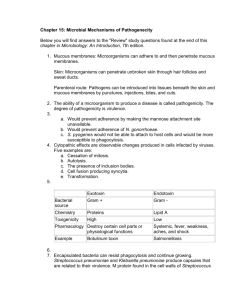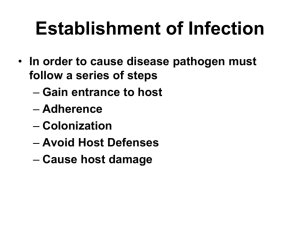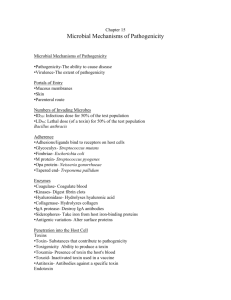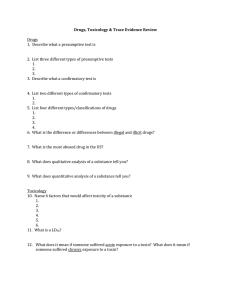Virulence of pathogens
advertisement
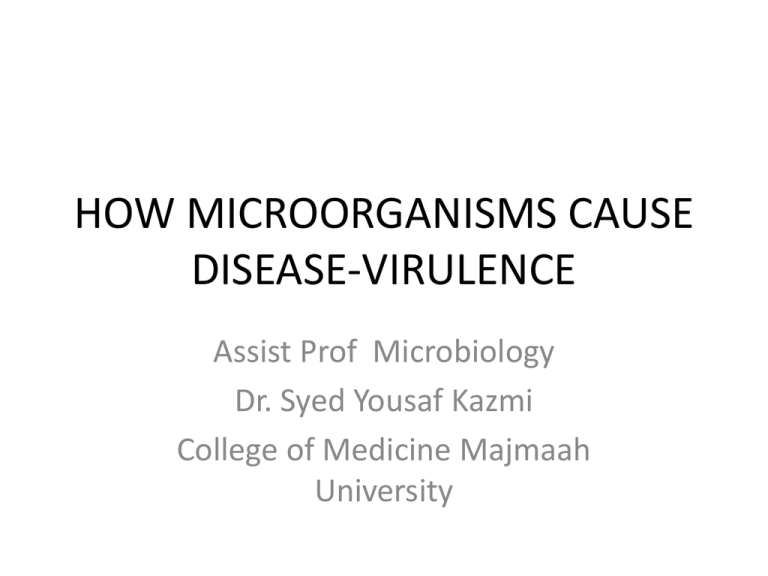
HOW MICROORGANISMS CAUSE DISEASE-VIRULENCE Assist Prof Microbiology Dr. Syed Yousaf Kazmi College of Medicine Majmaah University OBJECTIVES 1. 2. 3. 4. Name methods of transmission of infection Describe the process of infection List bacterial virulence factors Examples where bacterial virulence factors play important role in virulence, antibiotic susceptibility and host defence PATHOGENESIS • Pathogen- Org capable of causing disease • Opportunistic- Serious disease in immuno-compromised • Virulence-quantitative measure of pathogenicity • LD50 • ID50 • Shigella dysentrae and Vibrio cholerae VIBRIO CHOLERAE SHIGELLA DYSENTRAE PATHOGENESIS Infection and Disease production Microorganisms Number Body defenses Virulence Innate immunity DISEASE PRODUCTION Acquired immunity PATHOGENESIS COMMUNICABLE-inf spread from host to host (e.g. TB) CONTAGIOUS- highly communicable(Plague) ENDEMIC- constantly present in low levels in a population EPIDEMIC-occurs more freq than usual PANDEMIC- worldwide distribution SUBCLINICAL – overt symptoms, only Ab +ve(e.g. Hepatitis A) LATENT inf- org lie dormant, reactivation later(e.g. TB, Herpes simplex) CARRIER STATE- Multiply with/without producing symptoms in host(Typhoid Mary) STAGES OF BACTERIAL PATHOGENESIS 1. Transmission from external source into portal of entry 2. Evasion of primary host defenses 3. Adherence 4. Colonization 5. Invasion/ inflammation or Toxin production 6. Host responses 7. Progression/ resolution TRANSMISSION • Transmission of infection – Human to human – Nonhuman sources to human (fomites, soil, water, animals etc) • The clinical manifestations of diseases (e.g., diarrhea, cough, genital discharge) promote transmission of the agents • Endogenous vs Exogenous (Normal flora) TRANSMISSION • Vertical and Horizontal transmission • Portal of entry: Respiratory, GI, Urogenital tract or skin • Diseases for which animals are the reservoirs are called zoonoses • Animals can either – be the source (reservoir) or – mode of transmission (vector) ADHERENCE • Pili, capsules or glycocalyces allow Bacteria to adhere to the surface of human cells • Pili of Ns gonorrhoeae and E.coli : attach to urinary tract epith • Glycocalyx of Staph epidermidis and certain viridans streps : attach to heart valves • Adhesins: molecules mediating attachment to surfaces • IgA proteases→Cleaved Fc portion bind to bact that bind to cellular Fc rec Ns gonorrhoeae attaching to urinary epithelium via pili ADHERENCE Biofilm: protective matrix of polysaccharides and proteins Form on foreign bodies e.g. prosthetic joints, prosthetic heart valves, I/V catheters Native heart Protect bacteria from antibiotics & host immune defenses e.g. antibodies and neutrophils Persistence of Pseudomonas in the lungs of cystic fibrosis and Streptococci in dental plaques ADHERENCE • Bacteria can adhere to foreign body surfaces • Phagocytes adhere poorly: lack of selectins and adhesion molecules etc COLONIZATION & MULTIPLICATION • After adherence to the surfaces, bacteria colonize and multiply • Thereafter, many possible outcomes – Local damage and inflammation – Invasion and spread to distant sites – Toxin release – Cytolysins release INVASION & INFLAMMATION • Invasion followed by inflammation • Invasive bacteria secrete enzymes – – – – Collagenase and hyaluronidase Coagulase Immunoglobulin A (IgA) protease Catalase AVOIDING IMMUNE DESTRUCTION ANTIPHAGOCYTIC COMPONENTS 1. Capsule & Slime layer – Strep pneumoniae – H influenzae 2. Antiphagocytic surface components – Strep pyogenes M proteins – Ns gonorrhoea pili – Staph aureus Protein A 3. IgA proteases Structure of Strep pyogenes AVOIDING IMMUNE DESTRUCTION ANTIGENIC VARIATION – Ns gonorrhoeae outer membrane protein & pili – Enterobacteriaceae capsular & flagellar protein SURVIVING INTRACELLULARLY – Evading killing mechanisms • M tuberculosis inhibits phagolysosome fusion • Listeria escapes phagosome before phagolysosome fusion TOXIN PRODUCTION 1. EXOTOXINS • Extracellular • Secreted • Protein 2. ENDOTOXINS • Integral part of cell • Lipopolysaccharide • Toxic moiety is Lipid A FEATURES OF EXOTOXINS & ENDOTOXINS Property Exotoxin Endotoxin Source Certain species of Gram +ve & Gram –ve bacteria Cell wall of gram-negative bacteria Secreted by cell Yes No Chemistry Polypeptide Lipopolysaccharide Location of genes Plasmid or bacteriophage Bacterial chromosome Toxicity High (fatal dose ~1µg) Low (fatal dose ~1000µg) Clinical effects Various effects Fever, shock Mode of action Various modes Includes TNF & IL-1 Antigenicity Induces high-titer antitoxins Poorly antigenic Vaccines Toxoids used as vaccines No toxoids formed Heat stability Destroyed at 60°C(except staph entero) Stable at 100°C for 1 hour Typical diseases Tetanus, botulism, diphtheria Meningococcemia, sepsis EXOTOXINS • Secreted by bacteria • Polypeptides • Certain Gram +ve & Gram –ve org • Genes are on plasmid or lysogenic bacterial viruses (e.g. diphtheria toxin, cholera toxin, and botulinum toxin) • Very potent • Induce formation of Antitoxins • Toxins treated with formalin→ Toxoid retain antigenicity (Vaccines) EXOTOXINS • Most Exotoxins have A–B subunit structure – A subunit is active • possesses pathogenicity • Usually an Enzyme – B binds to the receptor • Exotoxins cause protein synthesis inhibition, neurotoxicity or can be cytolytic EXOTOXINS-PROTEIN SYNTHESIS INHIBITORS ORGANISM TOXIN MECH OF ACTION Primary Target C. diphtheriae Diphtheria ADP Ribosyl Heart, toxin transferase EF2 nerve, epithelium P. aeroginosa Exotoxin A ADP Ribosyl transferase EF2 Liver S. dysentreae Shiga toxin Interfere 60S ribosome Kidney, Endothelium of Blood ves EHEC Verotoxin Interfere 60S ribosome Intestine EXOTOXIN-NEUROTOXINS ORGANISM TOXIN MECH OF ACTION C. tetani Tetanus Blocks release toxin of inhibitory NT Glycine & GABA C. botulinum Botulinum Blocks release toxin of Acetylcholine at NMJ EFFECT Spastic contraction of muscles Flaccid paralysis EXOTOXINS-cAMP INDUCERS ORGANISM TOXIN MECH OF ACTION EFFECT V cholerae Cholera toxin ADP Ribosylate Gs Protein , that activates Adenyl cyclase—›↑cAMP Profuse diarrhea and vomiting ETEC E coli Heat labile toxin Similar to above Secretion of fluid and electrolytes B anthracis Anthrax toxin Edema factor Lethal factor Protective antigen Edema formation B pertussis Pertussis toxin ADP Ribosylate Gi Protein—› inactivates it & ↑cAMP levels Whooping cough symptoms MNEUMONIC: cAMP (cholera Anthrax Ecoli Pertussis) EXOTOXINS-SUPERANTIGEN • TSST of Strep pyogenes & Staph aureus • Erythrogenic toxin of Strep pyogenes • Enterotoxin of Staph aureus & C perferingens • Superantigens binds directly to class II MHC on antigenpresenting cells (macrophages) without intracellular processing • Release of large amounts of interleukins, esp IL-1 & IL-2 EXOTOXINS-CYTOLYSINS ORGANISM C perferingens Staph aureus TOXIN MECH OF ACT EFFECTS α Toxin Lecithinase Cell membrane damage, myonecrosis α Toxin Pore forming Leaky cell toxin (PVL) membrane→ death ENDOTOXINS • Integral parts of the cell walls • Endotoxins are lipopolysaccharides • Toxic moiety is lipid A • Produce the same generalized effects of fever and shock • Weakly antigenic • No toxoids ENDOTOXINS-BIOLOGICAL EFFECTS • Fever due to IL-1 & IL-6 • Hypotension, shock, and impaired perfusion due to TNF, NO, Bradykinins • DIC due to release of tissue factor • Inflammation & tissue damage due to activation of alternate pathway of complement MCQs • A 24-years-old man was admitted with sepsis due to a Gram negative bacillus. Patient exhibits high grade fever. Which component of Gram negative bacillus is responsible for high grade fever in this patient? • Enterotoxin • Hyaluronidase • Siderophore • Endotoxin • All of the following are correct concerning endotoxin EXCEPT: – They are part of the outer portion of the cell wall. – They are liberated if the bacterial cell wall breaks apart. – They are only present in gram positive cells. – They can lead to disseminated intravascular clotting. • Exotoxins have all the following characteristics EXCEPT: – – – – They are present in the LPS of the outer cell membrane. They are usually destroyed by heat. A small dose can be lethal. They can be converted to toxoids. • What cell structure does Neisseria gonorrhoeae use to attach and enter host epithelial cells? – – – – – Cell wall waxes Fimbriae M proteins Capsules Flagella • Capsules play a role in the virulence of all of the following except: – – – – – Mycobacterium tuberculosis Bacillus anthracis Klebsiella pneumoniae Haemophilus influenzae Yersinia pestis • Which of the following bacterial toxins binds to nerve cells, preventing chemical communication between nerve and muscle cells? – – – – – Erythrogenic toxin Staphylococcal enterotoxin Botulinum toxin Diphtheria toxin E. coli endotoxin • Which is true of endotoxins? – – – – – They are proteins. They are produced by gram-positive bacteria. They are disease-specific. They increase blood pressure. They are released upon cell lysis. • Which is not true of exotoxins? – They can produce protective antibodies called antitoxins. – The genetic material that encodes most of them is plasmid or prophage associated. – They can be converted to toxoids. – The exotoxin can work by binding and entering the host cell. – They rarely have enzymatic activity. • A laboratory developed antibody that reacts with mitochondrial antigen. This antibody was treated with different micro-organisms and Ag-Ab reaction was read with special equipment. Which of the following microorganism will be negative for this reaction? – – – – – Filamentous fungus Protozoan parasite Virus Yeast Cestode • A 45-years-old lady reported with non healing ulcer on leg. The histopathology report of the ulcer margin revealed granuloma. If the causative agent is a microorganism, which of the following will be true of this agent? – – – – – It has a lipopolysacharride It has pili It is an exotoxin producer It is a superantigen It is intracellular • A cancer chemotherapy patient has to have her intravenous catheter replaced after it was found to be blocked. The catheter was found to contain bacteria. Which of the following attributes is most likely to be a factor in this pathogenesis? – – – – – Ergosterol containing membrane Peptidoglycan layer Biofilm production Possession of IgA protease Possession of pili


